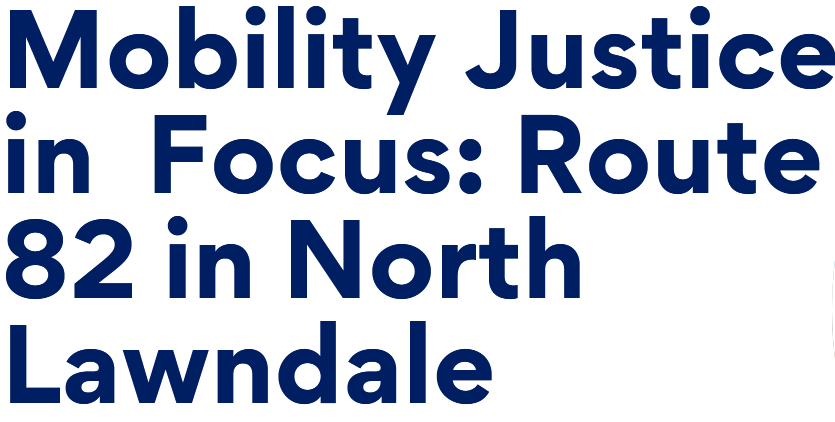Limitations
This report applies a radical understanding of mobility justice to the hyperlocal issue of Route 82 within North Lawndale. The authors acknowledge that issues surrounding public transit equity expand beyond North Lawndale and Route 82 into other disinvested areas of Chicago. The project team also acknowledges their position as urban planning students within a state institution, which influences their point of view from within academia and the planning industry rather than the community. In addition, the project team does not represent the racial or socioeconomic demographics of North Lawndale. In a further study of transit equity, more involved community collaboration would provide critical local perspectives. In addition, an expanded understanding of the social environment—including traffic, policing, and interpersonal violence—would complement this report’s insight into Route 82’s limitations corresponding to the built environment.
The project team was also limited by time and funding. As this project was conducted over the course of a semester, there was a set amount of time to gather data. Further research would benefit from an extended study period. The project was generously funded by the University of Illinois Chicago’s Office of Community Collaboration. Further research would require additional funding.
The CTA also faces factors that may limit their ability to improve reliability along Route 82. Street infrastructure, traffic lights, and other vehicles on the road affect bus service but are not owned by the CTA, therefore limiting the agency’s capacity to influence these factors. In addition, the CTA’s funding is constrained and faces a future operating deficit that may impact system improvements related to reliability.
Future Research
As mentioned in the Frequency and Reliability section of this report, factors beyond this project’s scope could provide more equitable service to North Lawndale. Future research should examine the effects of bus bunching, the addition of dedicated bus lanes, transit signal priority, winter bus stop conditions, road conditions, and land use around bus stops—all of which may influence reliability. Further research on Title VI metric standardization among transit agencies would also be helpful, as easier cross-comparison of agency data would provide transparency in methods and data across agencies.
To gain further insight into the community’s perceived equity of Route 82, future research should include insights from North Lawndale bus riders and bus operators. While the project team makes quantitatively informed assumptions in this report about Route 82 ridership pertaining to work, school, errands, and other necessities, an ethnographic study would provide further insight into the why individual North Lawndale residents ride the Route 82 bus and which specific needs can address inequitable service. In addition, engagement with bus operators working on Route 82 would be an insightful addition to this report’s research, perhaps in part through identifying challenges to service reliability. Bus operators are underrepresented in the literature on transit equity and would provide a different perspective on the nuances of Route 82 ridership in North Lawndale. The project team recommends that further research include ethnographic research focused on community members and bus operators.
Further research is also needed on the effects of programs such as The Chicago Region Tree Initiative (CRTI), a community forestry program that uses forestry data to determine which communities have the greatest need for trees. All census tracts within or intersecting North Lawndale are ranked as “highest” or “high” priority areas for CRTI due to extremely low canopy coverage, and an additional 41 percent of land in the neighborhood, including transit land, is classified as plantable space. Tree planting initiatives may be environmentally valuable, but need to be developed in partnership with community members in order to consider factors such as the perceived safety concerns and aesthetics of tree cover.
While this report does not offer recommendations, it should serve as a guide for transit agencies, professionals, and activists to view possible improvements to Route 82 through a mobility justice lens. As systemic disinvestment continues in North Lawndale, Route 82 serves as a connection to schools, places of work, other transit, and essential services for residents. To provide equitable access to these amenities, reliability and bus stop conditions must be addressed. Furthermore, enhanced service, rather than equal service, should be a priority for transit agencies when serving underserved communities like North Lawndale. Identifying these areas for improvement is the first step in the long and multifaceted process of ensuring an equitable Route 82. Supporting mobility justice—giving space and resources to the community to advocate on their own behalf and address injustices—is the ultimate aspiration of this report.
Continue Reading: Glossary
